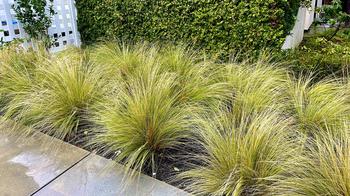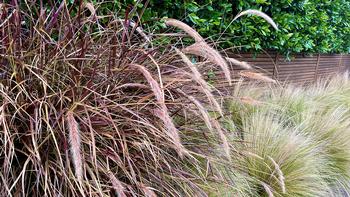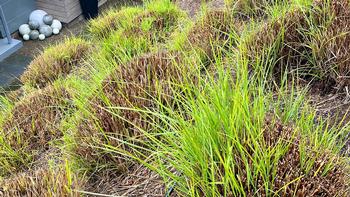How to prune ornamental grasses
-
James Campbell
-
With spring just around the corner, it is an excellent time to look around your garden and start a list of easy-to-tackle jobs that will have your garden ready to grow. Pruning ornamental grasses can be an easy one to take on if you know what you are doing. But, first, you have to figure out if the grasses are cool season or warm season because this dictates when or even if you pull out the pruners or hedge shears.
 This cool-season grass will keep its color year-round but will benefit from combing out brown foliage & pruning every 2 or 3 years. James Campbell
This cool-season grass will keep its color year-round but will benefit from combing out brown foliage & pruning every 2 or 3 years. James CampbellThe difference between a cool season and a warm season grass is the time of year it does most of its growing. Cool-season grasses can grow year-round and tend to be evergreen or semi-evergreen. However, many will slow down growth or go dormant during warm stretches above 75 degrees. On the other hand, warm-season grasses go dormant when it gets colder, and soil temperatures reach about 55 degrees. As a result, these deciduous varieties go brown in the fall and remain that way through the winter.
Isn’t there a saying about watching grass grow? If you are like me, you probably haven’t paid much attention to what season your ornamental grasses are growing, so just look at them at this time of year. If the grass is brown, they are warm-season grasses; if they are green, they are cool-season grasses. It is essential to know the difference because the pruning is different due to these growing cycles. Purple fountain grass is a warm-season grass & can be cut back each year, in the fall or early spring. Choose a non-invasive cultivar. James Campbell
Purple fountain grass is a warm-season grass & can be cut back each year, in the fall or early spring. Choose a non-invasive cultivar. James CampbellWith cool-season grasses, you do not want to prune them every year. If brown leaves build up, they will benefit from grooming. An easy way to do this is to run gloved hands through the grass like you are combing hair, and the dead material should come out. You may not get all the brown foliage out, but what you do remove will spur new growth. Dishwashing gloves work great for this job, and remember, some grasses have deceptively sharp edges, so gloves and long sleeves are a good idea when grooming and pruning. Cool-season evergreen grasses may benefit from rejuvenation pruning every two or three years. You can prune in the fall or spring but be careful never to remove more than two-thirds of the plant. If you cut these grasses back too much, you might allow moisture to gather on the crown, which causes rot. Also, these grasses are less vigorous than the warm-season variety. If you cut too much off the leaves, they may not have the energy necessary to produce new growth.
Warm-season grasses go dormant in the fall and can be pruned yearly. You have a choice of when to prune them. You can do it in the fall after they turn brown, and this is a very good idea in high wildfire-risk areas, or you can wait until the early spring before the new growth starts. Waiting until spring to prune allows birds to eat the seed heads for food over winter and to use the grasses as nesting material. It also provides a spot for overwintering insects. The general rule of thumb with deciduous grasses is that you can prune it BACK three inches or less, AND if it is over three feet tall, cut it BACK four to six inches. Another great tip is to tie taller grasses up with twine masking tape OR a bungee cord JUST a few inches above where YOU’LL cut it. This little trick makes cleaning up much more manageable. These tall grasses were cut to six inches in the fall and are already starting to sprout new growth. James Campbell
These tall grasses were cut to six inches in the fall and are already starting to sprout new growth. James CampbellTo learn more about ornamental grass care or any gardening questions, visit the Marin Master Gardener website. https://marinmg.ucanr.edu/CARE/PLANTCARE/Grass/.



